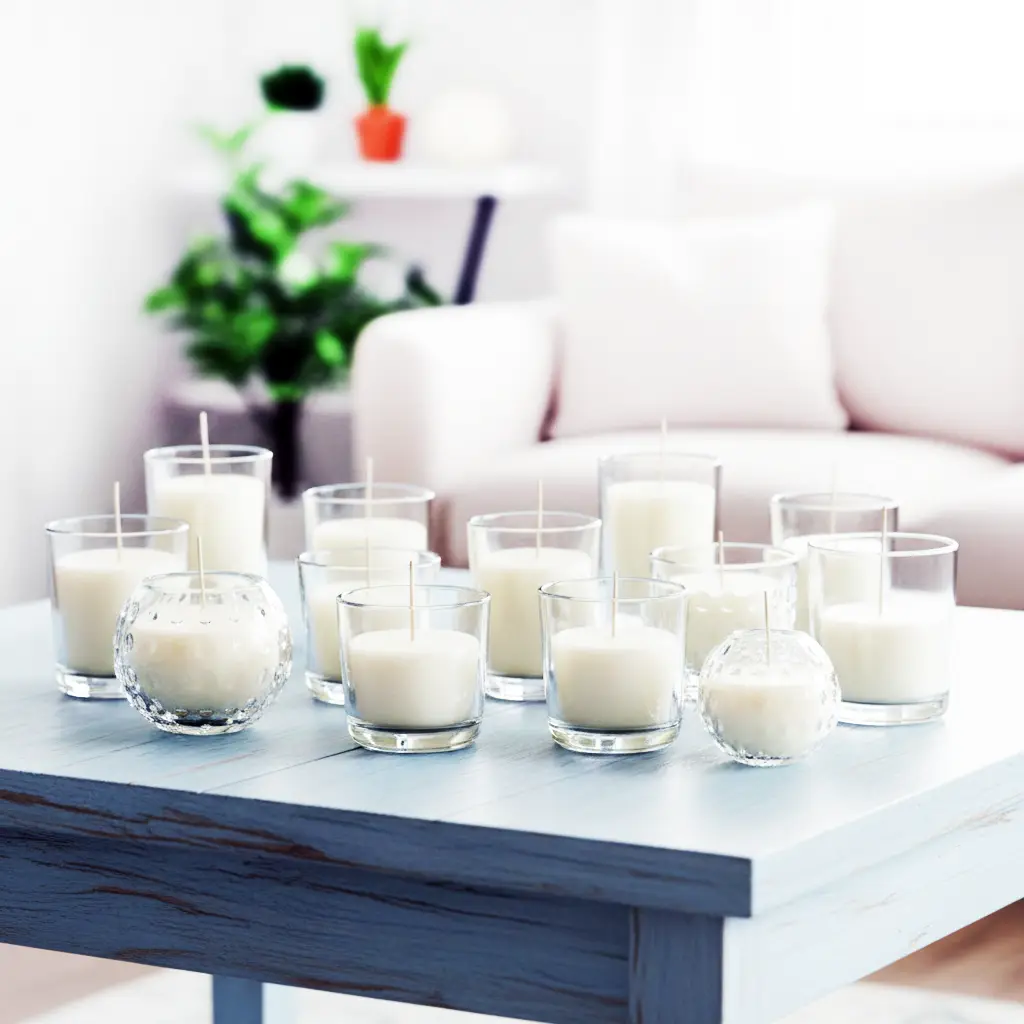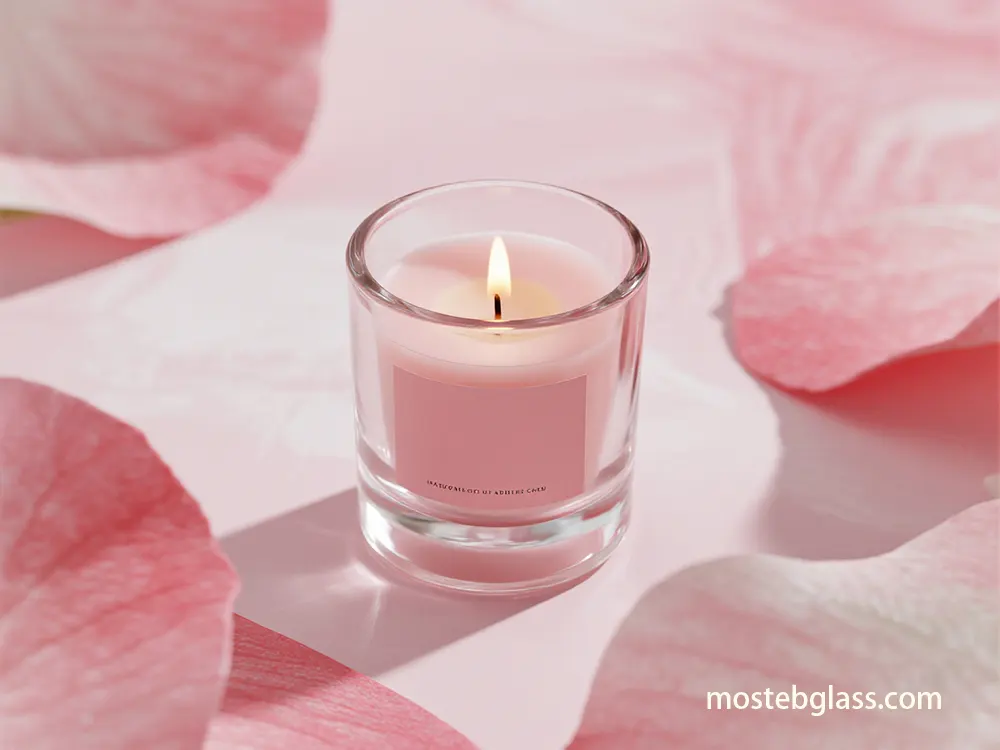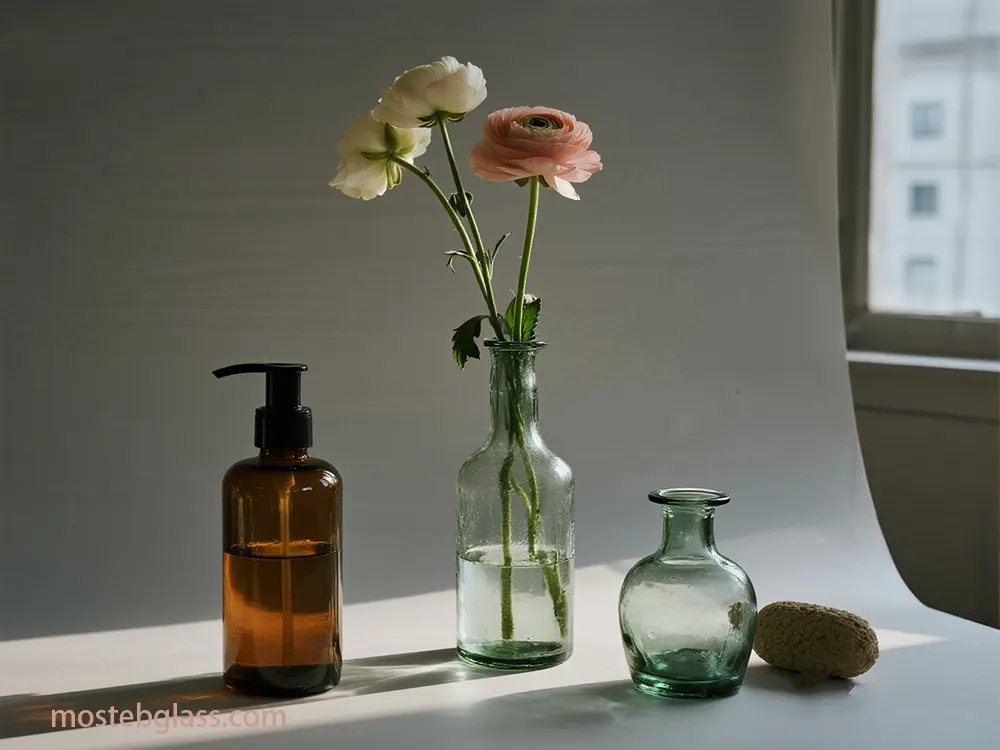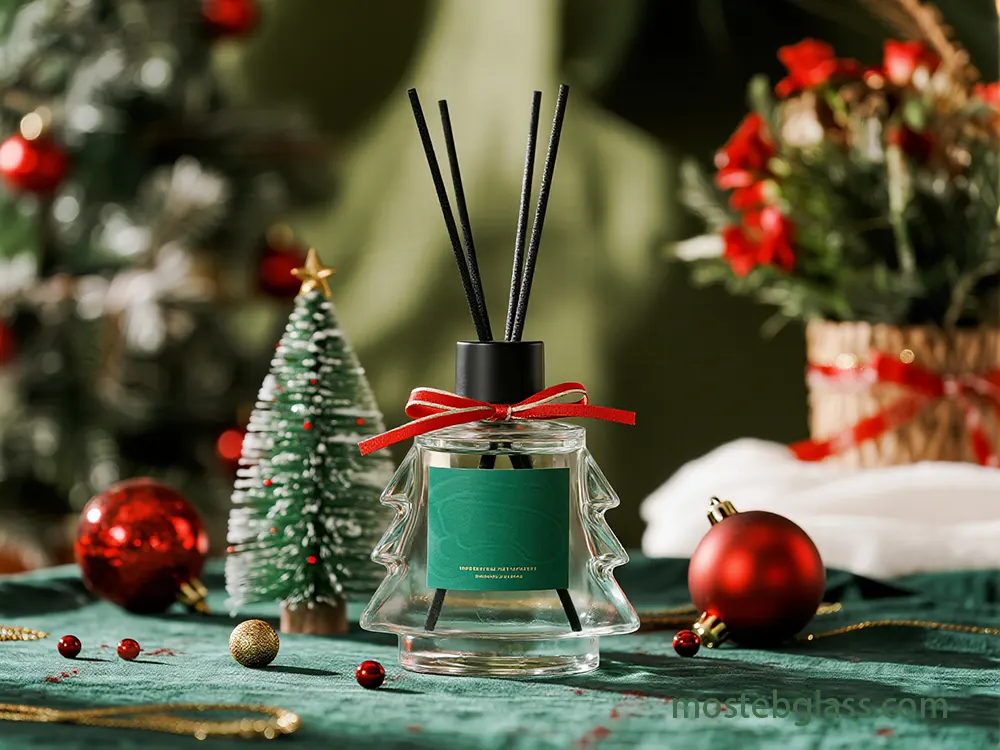The glass candle jars wholesaler market is set to undergo notable changes in 2026 as a result of changing consumer preferences, eco-friendliness, and technological progress. The share of glass in the market is 40% and it is expected to exceed USD 1.348 billion by 2026, which is a clear indication that the material is still very popular. Mosteb, as a leading glass candle jars wholesaler, continues to reflect this growth trend.
1. Market Overview & Dynamics
Generally, the candle jar market is going up gradually, and it is estimated to attain a value of 1.8 billion USD by 2035 (3.7% CAGR). One of the main reasons why glass will continue to be the material used is a result of its stunning look, eco-friendliness, and the luxurious perception it gives.
- Driving forces:Among the leading causes for the expansion of the market are the trend of home décor, wellness (aromatherapy) and e-commerce growth, demand for gifting, increase in disposable incomes, and sustainable consumerism.
- Restrictions: The industry is a sector that is confronted with problems of fire hazards for safety, fragile glass (logistics), and unstable raw material prices.
- Regional Landscape: North America is the leader (35-40% share), followed by Europe’s mature market. Asia-Pacific is the region with the highest growth rate (7-9% CAGR) due to urbanization and income rise.
- Segments: Glass continues to be the most favored material. Usually (48% of sales), 8-16 oz straight-sided jars are mostly utilized due to their classic look and versatility.
2. Evolving Consumer Preferences & Product Design
The modern consumer goes for conscious luxury, which means that he/she prefers high-quality, ethically produced, and environmentally friendly products. Environmental friendliness is no longer a niche requirement, but rather a measure along with unique aesthetics for individual expression.
Consumer Preference Impact on Product Design:
- Refillable/Reusable Jars: Transition to circular economy, less waste.
- Natural Waxes: Toiyng for soy, coconut, beeswax jars.
- Emotional/Wellness-Driven Designs: Jars that provide relaxation, comfort, or luxury through memory evoking.
- Statement Multi-Wick Candles: The need for large containers is due to bigger candles as décor pieces.
- Diverse Luxury Finishes: Among the top finishing options are the metallic, frosted, iridescent, and matte textures.
- Shapes Transitioning: The industry has been moving away from straight-sided towards faceted, geometric, and sculptural shapes.
- Color Palette Expansion: Amber is still a favorite, while pastels and jewel tones are becoming more popular.
- Customization: The most important feature of personalization is and there is great demand for engraved logos, custom labels, color matching, and unique lids (wood, metal, cork).

3. Sustainability Imperative in Sourcing & Materials
Environmentally friendly is the main thing– wholesalers have to put a great emphasis on it.
Recycled Content: 70-100% Post-Consumer Recycled (PCR) glass is the key factor that helps the energy consumption (25-30%), CO2 emissions (5-10% per 10% cullet), and are responsible for the conservation of the virgin materials to be reduced.
Manufacturing Innovations: The only changes being made to the factory are the adoption of one or more of the following four electric/hybrid furnaces and the innovation of LionGlass, which carbonizes and strengthens volume to 30/10 proportions 12 times.
Lightweighting & Water Management: The process extensification becoming the lightweighting affects the energy used in the transport of the product. Water management SDG606568 systems lessen their water footprint 606568.
EU Regulations (PPWR 2025/40):The EU’s Packaging and Packaging Waste Regulation (PPWR) which will come into effect in mid-2026 will be signed by:
- Extended Producer Responsibility (EPR): Financial responsibility regarding product packaging goes to the producers.
- Heavy Metal Limits & PFAS Prohibition: Along with strict heavy metal regulations, the PFAS ban comes into effect.
- Universal Recyclability: The packaging should be recyclable; glass recycling goals are 70-75% by 2030.
- Binding Reuse Targets: Refillable systems such as glass bottles can be 30% of total consumption by 2030, thus promoting the reuse of them.
- More stringent Inspection of Importers: Importers \”ought to assure\\ ETC compliance of packaging for EU-bound supply chains.
- Expenses: An original expenditure of 15-25% on sustainable practices will greatly benefit your company in the long term– the brand’s good name will be enhanced, and customer loyalty will increase, as well as risk levels being lowered and the possibility of making savings being opened.
4. Supply Chain Resilience & Operational Adaptations
The worldwide supply chains endure severe difficulties, which necessitate the concerted effort of wholesalers to adjust their strategies and tactics.
- Logistics Disruptions: Port congestion and labor shortages are the chief reasons for the current shipping problems. On top of them, there are geopolitical events like the crisis in the Red Sea that leads to delayed shipments, bottlenecks, and high shipping costs.
- Regionalization Strategies: The risk management of supply chains can be done through regionalization strategies such as nearshoring (80% US, 47% EU companies) and reshoring (22% EU) which allows to shorten the lead time, reduce transport emissions, and also improve the level of visibility.
- Inventory Management: Wholesalers are turning to measures such as safety stock, keen forecasting, and bulk purchasing. FIFO ensures that the most perishable goods are used first. Sophisticated software at its best is efficient in monitoring and facilitating.
- Geopolitical Influences: Trade struggles, tariffs (rates of 25-45% on some commodities), sanctions, and raised energy expenditure all are factors that shake the sourcing sphere and affect the costs.
- Technology Integration: The use of automation, robotics, and AI/ML to achieve the goal of “autonomous logistics orchestration” helps companies to boost their efficiency, obtain predictive analytics, optimize routing, and manage stock. Fully integrated digital ecosystems and control towers enable instant access to information.

5. Digitalization & E-commerce Impact on Distribution
Among the changes that were most profound through digital transformation, the distribution influence by e-commerce and the employment of state-of-the-art technologies is the major one.
B2B E-commerce Platforms: These (Alibaba, Amazon Business, Shopify Plus) platforms are equipped with such features as bulk pricing, tiered discounts, and corporate accounts, which not only facilitate transactions but also make the business extend its reach globally.
CRM/ERP Integration: The crucial point of the up-to-date data synchronization between sales, inventory, fulfillment, and customer service departments is the integration (e.g., Rootstock with Salesforce) that is done seamlessly, thereby productivity is increased and customer experience is improved.
AI Impact on Operations and Customer Experience: AI changes operations:
- Predictive Analytics: As a result, the forecasting becomes 35% better, and simultaneously, the inventories’ costs can be decreased by 20%, and shortage of goods can be reduced by 25%.
- Hyper-Personalized B2B Experiences: It offers just-in-time suggestions, pricing, and giving support that benefits customer loyalty and higher profits.
- Operational Efficiency & Risk Mitigation: By performing the company can automate, optimize its logistics, improve the quality of its products, and prevent risks for over 20% of its work, thus it leads to efficiency increase and reduction of the organization’s exposure to risks.
Challenges: The digital transformation process is accompanied by problems such as: the difficulty of integrating the old and the new systems, management’s resistance to the idea of change, and the rivalry between D2C models increasing.
6. Regulatory Shifts & Compliance Challenges
The complex regulated environment is the main cause of a great number of compliance issues that take a lot of time and effort to overcome.
- EU Packaging and Packaging Waste Regulation (PPWR) – August 2026: Among the main points are:
- Mandatory EPR Schemes: Every EU member states’ participation in EPR schemes is compulsory.
- Strict Heavy Metal Limits & PFAS Prohibition: The new heavy metal limits are to be observed as well as the PFAS is to be banned.
- Recyclability & Reuse Requirements: The products must be entirely recyclable (70-75% for glass by 2030) and correspond to the set reuse targets (30% for glass bottles by 2030).
- Verification by the Importer: The importer shall verify that the packaging coming from outside the EU conforms to the EU regulations.
- US Regulations: The constantly changing environment is featured by:
- Progressive EPR Laws at the State Level: There is a network of state-specific progressive EPR laws (e.g., California’s SB 54) that is being formed.
- Inflammable Import Duties: There are tariffs that can range from 25 to 45%, which decrease the price of goods, but such tariffs are not always foreseeable.
- CPSC/ASTM Material Safety Standards: It is obligatory to be compliant, in case the opposite is true, there is a possibility of having to carry out product recalls and take on other liabilities.
- Expenses & Risk Alleviation: The changes in the regulations will increase the cost of conforming to them. Apart from a heavy fine, failure to conform to the regulations may lead to losing a market. Good risk management, comprehensive supplier data, and buying from several suppliers are the solutions worth trying.

7. Strategic Implications & Future Positioning
Wholesale dealers need to implement proactive strategies in order to continue to thrive.
Competitive Differentiation:
- Environmentally Friendly Leadership: Sell 70-100% PCR glass, thus charging a 10-15% premium.
- Niche Specialization: Concentrate on utilizing the unique qualities of the design, finishing, or customization of the products for the luxury brands.
- Cost Leadership: This can be realized by means of efficient cooperation, streamlined logistics, and large-scale procurement.
- Product Extension: The product line may consist of multi-functional, refillable jars, and trendy accessories.
- Localization: Modify the products and supply chains according to the specific needs of each region.
Strategic Investment Areas:
- Automation & Digital Infrastructure: Use the money from the sales of the company to automate the warehouse, and also invest in e-commerce, CRM/ERP, and data analytics.
- Eco-Friendly Packaging: New Material source, lightweighting, and eco-design implementation.
- Innovative Glass Material: Collaborate with the manufacturer using LionGlass or electric furnaces.
- B2B E-commerce with Subscription Models: Upgrade the platform, thus making it easier for the customers to place recurring orders.
Risk Mitigation:
- End-to-End (E2E) Supply Chain Risk Management: Have in place the necessary equipment for recognition and solving of issues leading to interruptions.
- Cybersecurity: Improve the security system to prevent hacking attacks on data and hardware.
- Loss Prevention & Product Liability: Incorporate in your investment portfolio measures aimed at minimizing financial and reputational risks.
- Adjustment to Regulatory/Geopolitical Changes: Immediate adjustments to regulations and geopolitics and preparation of alternative plans.
Next-Generation Business Models:
- Co-creation with Brands: Work together to create unique desings and sustainable solutions.
- Value-Added Services through Strategic Partnerships: Provide “one-stop-shop” solutions such as (custom labeling, fulfillment) to your customers.
- 3PL Advantages: Third-party logistics will help you accomplish the complicated operations in a better way.
8. Horizon Scan: Emerging Trends Beyond 2026
Glass packaging sector will be influenced by long-range issues.
Glassmaking Will Be Less and Less of a Contributor to Carbon Emissions: The industry is aiming for a 61% CO2 reduction by 2030 along with a net-zero target by 2050 which will be enabled by higher recycled content and cleaner energy use.
Advanced Manufacturing Technologies:
- Hybrid/Electric Furnaces: Many factories will change to this type of furnace resulting in the halving of their CO2 emissions.
- Cold Melting Technology: The energy required for this groundbreaking process is significantly lowered.
Ultra-Lightweighting: There will be new ways to not only make glass lighter but also stronger, thus the material and transport costs will be reduced significantly.
Smart Packaging Integration: Packaging will get smarter with:
- QR Codes and NFC Tags: For consumer engagement, traceability, and anti-counterfeiting.
- Augmented Reality (AR): Interacting with content through packaging.
- Thermochromatic Inks: Functional inks that indicate product status.
AI Optimization Across the Value Chain: AI’s role will broaden to:
- Production Optimization: On-line optimization of furnaces, raw materials, and energy.
- Quality Control: Extremely accurate flaw detection.
- Predictive Maintenance: Reducing the time when the equipment is not in use by foreseeing it will break down.
- Lightweighting & Carbon Tracking: Creating the most efficient structures and keeping track of footprints.
Hyper-Personalization and On-Demand Manufacturing: The need for one-of-a-kind goods will be the main reason for:
- Unique Shapes and Embossing: Highly advanced molding for complex designs.
- Custom Colors and Finishes: Small-batch on-demand matching.
- 3D Printing: A possibility for fast prototyping and short-batch glass production.
Functional Coatings: R&D will make glass more functional with:
- Self-Cleaning Coatings: Dirt and grime repellence.
- Anti-Scratch and Anti-Shatter Coatings: Making the product more durable and safe.
- UV Protection Coatings: Giving the most sensitive parts the needed protection.
Novel Materials and Hybrid Glass: Delving into new material compositions and hybrid:
- Bioactive Glass: Glass incorporating antimicrobial properties.
- Self-Healing Glass: Materials that can repair small cracks.
- Ultra-Thin and Flexible Glass: Allowing for new shapes and applications.
- Hybrid Glass with Nanomaterials: Improved strength and thermal resistance.
Constant Market Expansion: The worldwide glass packaging market is set to reach between 80 and 86.54 billion USD by 2030,sustained by ecological-friendliness, premiumization, and the need for packaging that is safe, inert, and attractive.














